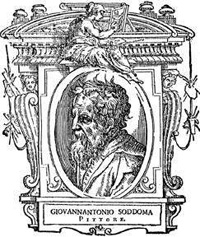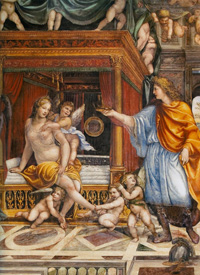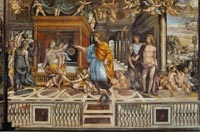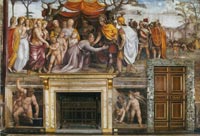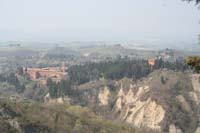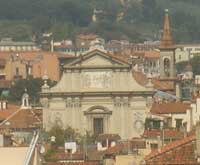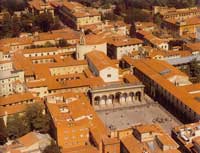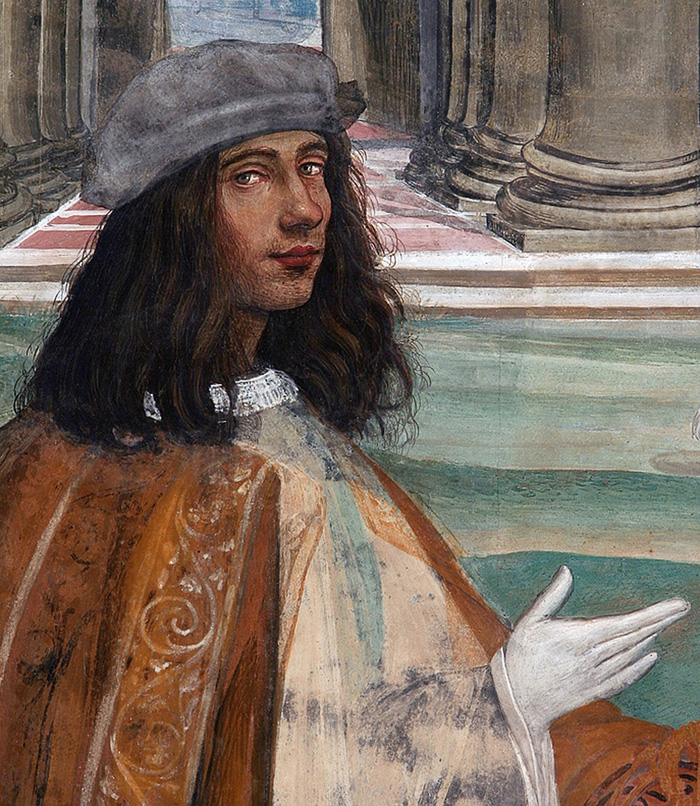 |
|
Il Sodoma, selfportrait, frescoe, Abbazia di Monte Oliveto Maggiore, Il Chiostro Grande |
|
Giorgio Vasari | Lives of the most Eminent Painters Sculptors and Architects GIOVANNI ANTONIO BAZZI, CALLED IL SODOMA |
| LIFE OF GIOVANNI ANTONIO BAZZI, CALLED IL SODOMA |
|
|
 Il Sodoma, autoritratto, fresco, Monte Oliveto Il Sodoma, autoritratto, fresco, Monte Oliveto |
|
||
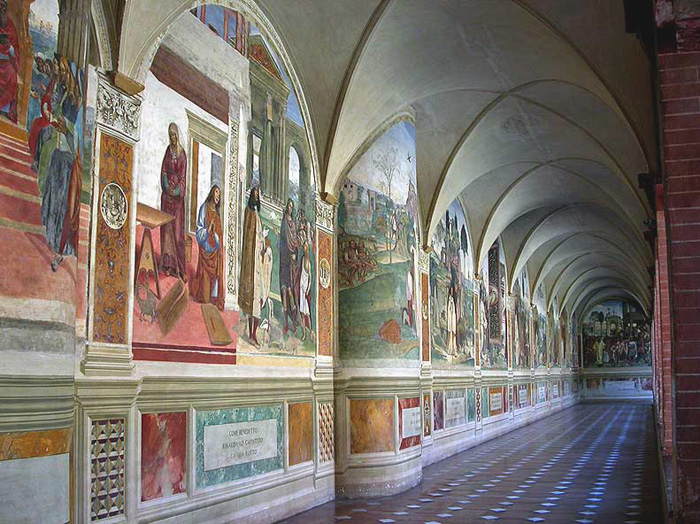 |
||
Storie di san Benedetto di Monte Oliveto Maggiore sono un ciclo di affreschi nel Chiostro Grande dell'Abbazia di Monte Oliveto Maggiore. |
||
Now this manner of living and his eccentric ways, with his works and pictures, wherein he did indeed achieve something of the good, caused him to have such a name among the people of Siena—that is, among the populace and the common herd, for the people of quality knew him better—that he was held by many to be a great man. Whereupon, Fra Domenico da Lecco, a Lombard, having been made General of the Monks of Monte Oliveto, Sodoma went to visit him at Monte Oliveto di Chiusuri, the principal seat of that Order, distant fifteen miles from Siena; and he so contrived with his persuasive words, that he was commissioned to finish the stories of the life of S. Benedict, part of which had been executed on a wall by Luca Signorelli of Cortona. This work he finished for a small enough price, besides the expenses that he incurred, and those of certain lads and colour-grinders who assisted him; nor would it be possible to describe the amusement that he gave while he was labouring at that place to those fathers, who called him Il Mattaccio, in the mad pranks that he played. |
||
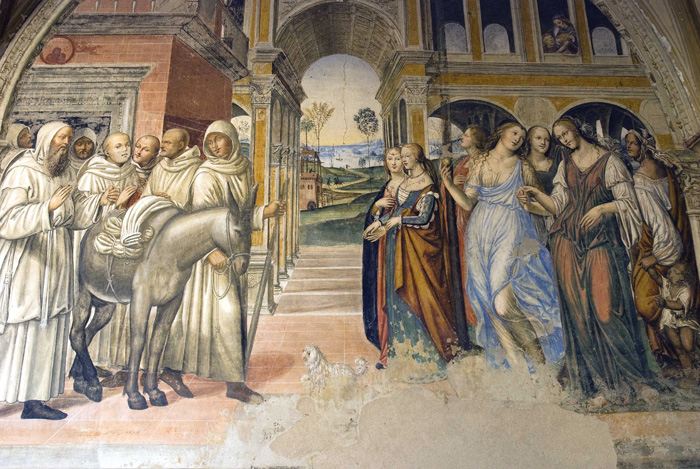 |
||
Come florenzo manda male femmine al monastero, frescoe in the Chiostro Grande dell'Abbazia di Monte Oliveto Maggiore |
||
But to return to the work. Having executed there certain scenes, which he hurried over mechanically and without diligence, and the General complaining of this, Mattaccio said that he worked as he felt inclined, and that his brush danced to the tune of money, so that, if the General consented to spend more, he was confident that he could do much better. The General having therefore promised that he would pay him better for the future, Giovanni Antonio painted three scenes, which still remained to be executed in the corners, with so much more study and diligence than he had shown in the others, that they proved to be much finer. In one of these is S. Benedict departing from Norcia and from his father and mother, in order to go to study in Rome; in the second, S. Mauro and S. Placido as children, presented to him and offered to God by their fathers; and in the third, the Goths burning Monte Cassino. For the last, in order to do despite to the General and the Monks, he painted the story of the priest Fiorenzo, the enemy of S. Benedict, bringing many loose women to dance and sing around the monastery of that holy man, in order to tempt the purity of those fathers. In this scene Sodoma, who was as shameless in his painting as in his other actions, painted a dance of nude women, altogether lewd and shameful; and, since he would not have been allowed to do it, as long as he was at work he would never let any of the monks see it. Wherefore, when the scene was uncovered, the General wished by hook or by crook to throw it to the ground and utterly destroy it; but Mattaccio, after much foolish talk, seeing that father in anger, clothed all the naked women in that work, which is one of the best that are there. Under each of these scenes he painted two medallions, and in each medallion a friar, to represent all the Generals who had ruled that congregation. And, since he had not their portraits from life, Mattaccio did most of the heads from fancy, and in some he portrayed old friars who were in the monastery at that time, and in the end he came to paint the head of the above-named Fra Domenico da Lecco, who was their General in those days, as has been related, and was causing him to execute that work. But, after some of those heads had lost the eyes, and others had been damaged, Fra Antonio Bentivogli, the Bolognese, caused them all to be removed, for good reasons. |
||
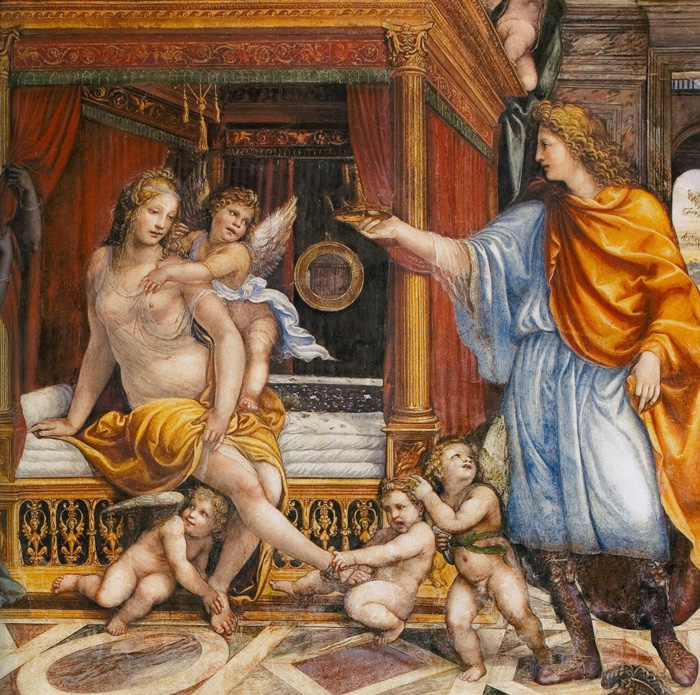 |
||
Il Sodoma, Le Nozze di Alessandro e Rossane (dettaglio), 1519, Villa Farnesina, Roma
|
||
During this time there arrived in Siena Agostino Chigi, a very rich and famous merchant of that city, and he became acquainted with Giovanni Antonio, both on account of his follies and because he had the name of a good painter. Wherefore he took him in his company to Rome, where Pope Julius II was then causing the Papal apartments in the Palace of the Vatican, which Pope Nicholas V had formerly erected, to be painted; and Chigi so went to work with the Pope, that some painting was given also to Sodoma. Now Pietro Perugino, who was painting the ceiling of an apartment that is beside the Borgia Tower, was working at his ease, like the old man that he was, and was not able to set his hand to anything else, as he had been at first commanded to do: and there was given to Giovanni Antonio to paint another apartment, which is beside the one that Perugino was painting. Having therefore set his hand to it, he made the ornamentation of that ceiling with cornices, foliage, and friezes; and then, in some large medallions, he executed certain passing good scenes in fresco. But this animal, devoting his attention to his beasts and his follies, would not press the work forward; and therefore, after Raffaello da Urbino had been brought to Rome by the architect Bramante, and it had become known to the Pope how much he surpassed the others, his Holiness ordained that neither Perugino nor Giovanni Antonio should work any more in the above-named apartments; indeed, that everything should be thrown to the ground. But Raffaello, who was goodness and modesty in person, left standing all that had been done by Perugino, who had once been his master; and of Mattaccio's he destroyed nothing save the inner work and the figures of the medallions and scenes, leaving the friezes and the other ornaments, which are still round the figures that Raffaello painted there, which were Justice, Universal Knowledge, Poetry, and Theology. But Agostino, who was a gentleman, without paying any attention to the affront that Giovanni Antonio had received, commissioned him to paint in one of his principal apartments, which opens into the great hall in his Palace in the Trastevere, the story of Alexander going to sleep with Roxana. In that work, besides other figures, he painted a good number of Loves, some of whom are unfastening Alexander's cuirass, some are drawing off his boots, or rather, buskins, some are removing his helmet and dress, and putting them away; others scattering flowers over the bed, and others, again, doing other suchlike offices. Near the chimney-piece he painted a Vulcan forging arrows, which was held at that time to be a passing good and praiseworthy work; and if Mattaccio, who had beautiful gifts and was much assisted by Nature, had given his attention, after that reversal of fortune, to his studies, as any other man would have done, he would have made very great proficience. But he had his mind always set on his amusements, and he worked by caprice, caring for nothing so earnestly as for dressing in pompous fashion, wearing doublets of brocade, cloaks all adorned with cloth of gold, the richest caps, necklaces, and other suchlike fripperies only fit for clowns and charlatans; in which things Agostino, who liked the man's humour, found the greatest amusement in the world. Julius II having then come to his death, and Leo X having been elected, who took pleasure in eccentric and light-headed figures of fun such as our painter was, Mattaccio felt the greatest possible joy, particularly because he had an ill-will against Julius, who had done him that affront, wherefore, having set to work in order to make himself known to the new Pontiff, he painted in a picture the Roman Lucrece, nude, who was stabbing herself with a dagger; and, since Fortune takes care of madmen and sometimes aids the thoughtless, he succeeded in executing a most beautiful female body, and a head that was breathing. Which work finished, at the instance of Agostino Chigi, who was on terms of strait service with the Pope, he presented it to his Holiness, by whom he was made a Chevalier and rewarded for so beautiful a picture. Whereupon Giovanni Antonio, believing that he had become a great man, began to be disinclined to work any more, save when he was driven by necessity. But, after Agostino had gone on some business to Siena, taking Giovanni Antonio with him, while staying there he was forced, being a Chevalier without an income, to set himself to painting; and so he painted an altar-piece containing a Christ taken down from the Cross, on the ground Our Lady in a swoon, and a man in armour who, having his back turned, shows his front reflected in a helmet that is on the ground, bright as a mirror. This work, which was held to be, as it is, one of the best that he ever executed, was placed in S. Francesco, on the right hand as one enters the church. Then in the cloister that is beside the above-named church, he painted in fresco Christ scourged at the Column, with many Jews around Pilate, and with a range of columns drawn in perspective after the manner of wing-walls; in which work Giovanni Antonio made a portrait of himself without any beard—that is, shaven—and with the hair long, as it was worn at that time. Not long afterwards he executed some pictures for Signor Jacopo VI of Piombino, and, while living with him at that place, some other works on canvas. Wherefore by his means, besides many courtesies and presents that he received from him, Giovanni Antonio obtained from his island of Elba many little animals such as that island produces, all of which he took to Siena. |
||
|
||
S. SEBASTIAN (After the painting by Giovanni Antonio [Il Sodoma]. Florence: Uffizi, 1279) Anderson |
||
Arriving next in Florence, a monk of the Brandolini family, Abbot of the Monastery of Monte Oliveto, which is without the Porta a S. Friano, caused him to paint some pictures in fresco on the wall of the refectory; but since, like a careless fellow, he did them without study, they proved to be such that he was derided and mocked at for his follies by those who were expecting that he would do some extraordinary work. Now, while he was engaged on that work, having taken a Barbary horse with him to Florence, he set it to run in the race of S. Barnaba; and, as fortune would have it, the horse ran so much better than the others, that it won. Whereupon, the boys having, as is the custom, to call out the name or by-name of the owner of the horse that had won, after the running of the race and the fanfare of trumpets, Giovanni Antonio was asked what name they were to call out; and, after he had replied, "Sodoma, Sodoma," the boys called out that name. But some honest old men, having heard that filthy name, began to protest against it and to say, "What filthy thing is this, and what ribaldry, that so vile a name should be cried through our city?" Insomuch that, a clamour arising, poor Sodoma came within an ace of being stoned by the boys and the populace, with his horse and the ape that he had with him on the crupper. Having in the space of many years got together many prizes, won in the same way by his horses, he took the greatest pride in the world in them, and showed them to all who came into his house; and very often he made a show of them at his windows. But to return to his works: he painted for the Company of S. Bastiano in Camollia, beyond the Church of the Umiliati, on a banner of cloth which is carried in processions, in oils, a nude S. Sebastian, bound to a tree, who is standing on the right leg, with the left in foreshortening, and raises the head towards an Angel who is placing a crown upon it. This work is truly beautiful, and much to be praised. On the reverse side is Our Lady with the Child in her arms, and below her are S. Gismondo, S. Rocco, and some Flagellants kneeling on the ground. It is said that some merchants of Lucca offered to give three hundred crowns of gold to the men of that Company for that picture, but did not obtain it, because the others did not wish to deprive their Company and the city of so rare a painting. And, in truth, in certain works—whether it was study, or good fortune, or chance—Sodoma acquitted himself very well; but of such he did very few. In the Sacristy of the Friars of the Carmine is a picture by the hand of the same master, wherein is a very beautiful Nativity of Our Lady, with some nurses; and on the corner near the Piazza de' Tolomei he painted in fresco, for the Guild of Shoemakers, a Madonna with the Child in her arms, S. John, S. Francis, S. Rocco, and S. Crispino, the Patron Saint of the men of that Guild, who has a shoe in his hand. In the heads of these figures, and in all the rest, Giovanni Antonio acquitted himself very well. In the Company of S. Bernardino of Siena, beside the Church of S. Francesco, he executed some scenes in fresco in competition with Girolamo del Pacchia, a Sienese painter, and Domenico Beccafumi—namely, the Presentation of Our Lady in the Temple, when she goes to visit S. Elizabeth, her Assumption, and when she is crowned in Heaven. In the angles of the same Company he painted a Saint in episcopal robes, S. Louis, and S. Anthony of Padua; but the best figure of all is a S. Francis, who, standing on his feet and raising his head, is gazing at a little Angel, who appears to be in the act of speaking to him; the head of which S. Francis is truly marvellous. In the Palazzo de' Signori at Siena, likewise, in a hall, he painted some little tabernacles full of columns and little children, with other ornaments; and within these tabernacles are various figures. In one is S. Vittorio armed in the ancient fashion, with the sword in his hand; near him, in the same manner, is S. Ansano, who is baptizing certain persons; in another is S. Benedict; and all are very beautiful. In the lower part of that Palace, where salt is sold, he painted a Christ who is returning to life, with some soldiers about the Sepulchre, and two little Angels, held to be passing beautiful in the heads. Farther on, over a door, is a Madonna with the Child in her arms, painted by him in fresco, and two Saints. |
||
|
||
S. ANSANO (After the fresco by Giovanni Antonio Bazzi [Il Sodoma]. Siena: Palazzo Pubblico) Alinari |
||
In S. Spirito he painted the Chapel of S. Jacopo, which he did at the commission of the men of the Spanish colony, who have their place of burial there; depicting there an image of the Madonna after the ancient manner, with S. Nicholas of Tolentino on the right hand, and, on the left, the Archangel S. Michael, who is slaying Lucifer. Above these, in a lunette, he painted Our Lady placing the sacerdotal habit upon a Saint, with some Angels around. Over all these figures, which are in oils on panel, there is painted in fresco, in the semicircle of the vaulting, a S. James in armour on a galloping horse, who has grasped his sword with a fiery gesture, and below him are many Turks, dead and wounded. Below all this, on the sides of the altar, are painted in fresco S. Anthony the Abbot and a nude S. Sebastian at the Column, which are held to be passing good works. |
||
|
||
S. FRANCIS (After the fresco by Giovanni Antonio Bazzi [Il Sodoma]. Siena: S. Bernardino, Oratory) Alinari |
||
In the Duomo of the same city, on the right hand as one enters the church, there is upon an altar a picture in oils by his hand, in which there are Our Lady with the Child on her knee, S. Joseph on one side, and S. Calixtus on the other; which work is likewise held to be very beautiful, because it is evident that in colouring it Sodoma showed much more diligence than he used to devote to his works. He also painted for the Company of the Trinity a bier for carrying the dead to burial, which was very beautiful; and he executed another for the Company of Death, which is held to be the most beautiful in Siena; and I believe that the latter is the finest that there is to be seen, for, besides that it is indeed much to be extolled, it is very seldom that such works are executed at much cost or with much diligence. In the Church of S. Domenico, in the Chapel of S. Caterina da Siena, where there is in a tabernacle the head of that Saint, enclosed in one of silver, Giovanni Antonio painted two scenes, which are one on either side of that tabernacle. In one, on the right hand, is that Saint when, having received the Stigmata from Jesus Christ, who is in the air, she lies half-dead in the arms of two of her sisters, who are supporting her; of which work Baldassarre Peruzzi, the painter of Siena, after considering it, said that he had never seen anyone represent better the expression of persons fainting and half-dead, or with more similitude to the reality, than Giovanni Antonio had contrived to do. And in truth it is so, as may be seen, apart from the work itself, from the design by Sodoma's own hand which I have in my book of drawings. On the left hand, in the other picture, is the scene when the Angel of God carries to the same Saint the Host of the most Holy Communion, and she, raising her head to Heaven, sees Jesus Christ and Mary the Virgin, while two of her sisters, her companions, stand behind her. In another scene, which is on the wall on the right hand, is painted the story of a criminal, who, going to be beheaded, would not be converted or commend himself to God, despairing of His mercy; when, the above-named Saint praying for him on her knees, her prayers were so acceptable to the goodness of God, that, when the felon's head was cut off, his soul was seen ascending to Heaven; such power with the mercy of God have the prayers of those saintly persons who are in His grace. In this scene is a very great number of figures, as to which no one should marvel if they are not of the highest perfection, for the reason that I have heard as a fact that Giovanni Antonio had sunk to such a pitch in his negligence and slothfulness, that he would make neither designs nor cartoons when he had any work of that kind to execute, but would attack the work by designing it with the brush directly on the plaster, which was a strange thing; in which method it is evident that this scene was executed by him. The same master also painted the arch in front of that chapel, making therein a God the Father. The other scenes in that chapel were not finished by him, partly from his own fault, he not choosing to work save by caprice, and partly because he had not been paid by him who was having the chapel painted. Below this is a God the Father, who has beneath Him a Virgin in the ancient manner, on panel, with S. Dominic, S. Gismondo, S. Sebastian, and S. Catharine. |
||
|
||
THE ADORATION OF THE MAGI (After the painting by Giovanni Antonio Bazzi [Il Sodoma]. Siena: S. Agostino) Alinari |
||
For S. Agostino, in an altar-piece that is on the right hand at the entrance into the church, he painted the Adoration of the Magi, which was held to be, and is, a good work, for the reason that, besides the Madonna, which is much extolled, the first of the three Magi, and certain horses, there is a head of a shepherd between two trees which has all the appearance of life. Over a gate of the city, called the Porta di S. Viene, he painted in fresco, in a large tabernacle, the Nativity of Jesus Christ, with some Angels in the air; and on the arch of that gate a child in foreshortening, very beautiful and in strong relief, which is intended to signify that the Word has been made Flesh. In this work Sodoma made a portrait of himself, with a beard, being now old, and with a brush in his hand, which is pointing to a scroll that says "Feci." He painted likewise in fresco the Chapel of the Commune at the foot of the Palace, in the Piazza, representing there Our Lady with the Child in her arms, upheld by some little Angels, S. Ansano, S. Vittorio, S. Augustine, and S. James; and above this, in a triangular lunette, he painted a God the Father with some Angels about Him. From this work it is evident that when he executed it he was beginning, as it were, to have no more love for art, having lost that certain quality of excellence that he used to have in his better days, by means of which he gave a certain air of beauty to his heads, which made them graceful and lovely. And this is manifestly true, for some works that he executed long before this one have quite another grace and another manner, as may be seen above the Postierla, from a wall in fresco over the door of the Captain Lorenzo Mariscotti, where there is a Dead Christ in the lap of His Mother, who has a marvellous divinity and grace. In like manner, a picture in oils of Our Lady, which he painted for Messer Enea Savini della Costerella, is much extolled, and also a canvas that he executed for Assuero Rettori of S. Martino, in which is the Roman Lucrece stabbing herself, while she is held by her father and her husband, all painted with much beauty of attitude and marvellous grace in the heads. Finally, perceiving that the devotion of the people of Siena was all turned to the talents and excellent works of Domenico Beccafumi, and possessing neither house nor revenues in Siena, and having by that time consumed almost all his property and become old and poor, Giovanni Antonio departed from Siena almost in despair and went off to Volterra. And there, as his good fortune would have it, chancing upon Messer Lorenzo di Galeotto de' Medici, a rich and honoured nobleman, he proceeded to live under his protection, with the intention of staying there a long time. And so, dwelling in the house of that nobleman, he painted for him on a canvas the Chariot of the Sun, which, having been badly guided by Phaëthon, is falling into the Po; but it is easy to see that he did that work to pass the time, and hurried through it by rule of thumb, without giving any thought to it, so entirely commonplace is it and so ill-considered. Then, having grown weary of living at Volterra and in the house of that nobleman, as one who was accustomed to being free, he departed and went off to Pisa, where, at the instance of Battista del Cervelliera, he executed two pictures for Messer Bastiano della Seta, the Warden of Works of the Duomo, which were placed in the recess behind the high-altar of that Duomo, beside those of Sogliani and Beccafumi. In one is the Dead Christ with Our Lady and the other Maries, and in the other Abraham sacrificing his son Isaac; but since these pictures did not succeed very well, the Warden, who had intended to make him paint some altar-pieces for the church, dismissed him, knowing that men who do not study, once they have lost in old age the quality of excellence that they had in their youth from nature, are left with a kind of facility of manner that is generally little to be praised. At that same time Giovanni Antonio finished an altar-piece that he had previously begun in oils for S. Maria della Spina, painting in it Our Lady with the Child in her arms, with S. Mary Magdalene and S. Catharine kneeling before her, and S. John, S. Sebastian, and S. Joseph standing at the sides; in all which figures he acquitted himself much better than in the two pictures for the Duomo. Then, having nothing more to do at Pisa, he made his way to Lucca, where, at S. Ponziano, a seat of the Monks of Monte Oliveto, an Abbot of his acquaintance caused him to paint a Madonna on the ascent of a staircase that leads to the dormitory. That work finished, he returned weary, old, and poor to Siena, where he did not live much longer; for he fell ill, through not having anyone to look after him or any means of sustenance, and went off to the Great Hospital, and there in a few weeks he finished the course of his life. |
||
|
||
THE SACRIFICE OF ISAAC (After the painting by Giovanni Antonio Bazzi [Il Sodoma]. Pisa: Duomo) Alinari |
||
Giovanni Antonio, when young and in good repute, took for his wife in Siena a girl born of a very good family, and had by her in the first year a daughter. But after that, having grown weary of her, because he was a beast, he would never see her more; and she, therefore, withdrawing by herself, lived always on her own earnings and on the interest of her dowry, bearing with great and endless patience the beastliness and the follies of that husband of hers, who was truly worthy of the name of Mattaccio which, as has been related, the Monks of Monte Oliveto gave him. [Pg 257] Riccio of Siena, the disciple of Giovanni Antonio, a passing able and well-practised painter, having taken as his wife his master's daughter, who had been very well and decently brought up by her mother, became the heir to all the possessions connected with art of his wife's father. This Riccio, I say, has executed many beautiful and praiseworthy works at Siena and elsewhere, and has decorated with stucco and pictures in fresco a chapel in the Duomo of the above-named city, on the left hand as one enters the church; and he now lives at Lucca, where he has done, as he still continues to do, many beautiful works worthy to be extolled. A pupil of Giovanni Antonio, likewise, was a young man who was called Giomo del Sodoma; but, since he died young, and was not able to give more than a small proof of his genius and knowledge, there is no need to say more about him. Sodoma lived seventy-five years, and died in the year 1554. |
||
[1] 'Considered the first art historian and often referred to as the “father of art history”, Varsari was the son of Antonio Vasari (d. 1527), a potter, and Maddelena Tacci (d. 1558). He learned Latin and other humanist disciplines in the 1520’s by Antonio da Saccone and Giovanni Pollastra (1465–1540). Throughout his career, Vasari practiced as an artist. He entered the Arezzo studio of Guillaume de Marcillat, whose previous commissions at the Vatican in Rome brought Vasari into conversance with the work of Michelangelo and Raphael. Vasari’s own painting led the Cardinal of Cortona, Silvio Passerini (1470–1529), tutor of Alessandro and Ippolito de’ Medici, to take Vasari with him to Florence in 1524. There Vasari and the two Medici received further instruction by Pierio Valeriano (1477–1558). Vasari also trained during this time in the Florentine workshops of Andrea del Sarto and Baccio Bandinelli, under Francesco Salviati. Forced to return to Arezzo when the Medici were expelled in 1527, Vasari entered the service of Cardinal Ippolito de’ Medici in January 1532. He studied ancient and modern Roman art and architecture again with Salviati. There he also met Paolo Giovio, an important force for his Vite years later. When Alessandro de’ Medici was murdered in 1537, Vasari was once again devoid of a princely patron. From that point on, he decided to exist on his own. He painted several work for the monks at Camaldoli before journeying to Rome in 1538, accompanied by his assistant Giovanni Battista Cungi. Already he was interested in studying ancient with a view of their effect on contemporary art, the core idea later into his masterwork of writing, the Vite. Vasari went to Venice in 1541. After about seven years of writing, Vasari published his most famous book, Le vite de più eccellenti architetti, pittori, et scultori in 1550. The printer was the Florentine humanist Lorenzo Torrentino (d. 1563). The two-volume, octavo work was dedicated to Cosimo de’ Medici. After its appearance several other biographies of artists appeared, most notably the life of Michelangelo by Asconio Condivi (q.v.). Vasari corrected and enlarged his text, issuing a second edition in 1568. It is this version that all subsequent editions and translations are based, and for which Vasari owes his fame. The work is divided into a preface (proemio), a discussion of the various media, and then three sections devoted to artist biographies arranged chronologically. When Vasari wrote his lives he was concerned mainly with Florentine artists. The first section covers Cimabue to Lorenzo di Bicci, section two from Jacopo della Quercia to Pietro Perugino, and the final section, from Leonardo da Vinci to Michelangelo. Michelangelo was the only artist still living when the Vite appeared. Vasari ends with a section to ‘artists and readers’. Several indexes complete the work. Chronological biographies of artists had previously existed. Vasari’s contribution was to create a critical, i.e., evaluative, history of artistic style, although he was far from unbiased. Core to Vasari was the notion of the rebirth of art, a rinascita. Art had a history and by new birth, it reestablished itself as a noble pursuit worthy of study. Vasari’s division art history into ages took as its paradigm the stages of human development. This, too, was not a novel conception with Vasari, but in his book, it took on a logical sense of order. Art’s early perfection was the antique, but hade then declined under Constantine. This low period of barbaric or Germanic art (“Gothic” Vasari called it) far removed from classical models, was ready for renaissance. Cimabue, Giotto and others formed the naissance of art, inspired by the imitation of nature, a primary stage (primi lumi). A developmental period (augumento) was ultimately succeeded by the age of perfection (perfezione)--coincidentally Vasari’s own time and that of Michelangelo. Vasari’s book created a sensation. Benvenuto Cellini found much fault, but Michelangelo, Gherardi, Salviati and Carlo Fontana praised it. Vasari wrote a second book, somewhat of a supplement to the Lives, entitled Ragionamenti sopra le Invenzioni. Appearing after his death in 1588, the book is a catalog of the allegorical compositions in the Palazzo Vecchio.' [Sources: Kultermann, Udo. Geschichte der Kunstgeschichte: Der Weg einer Wissenschaft. 2nd ed. Frankfurt am Main and Vienna: Ullstein, 1981, p. 438 n. 9; Blunt, Anthony. Artistic Theory in Italy: 1450-1600. Oxford: Clarendon Press, 1962, pp. 86-102; Kleinbauer, W. Eugene. Modern Perspectives in Western Art History: An Anthology of 20th-Century Writings on the Visual Arts. New York: Holt, Rinehart and Winston, 1971, pp. 68-9; Rud, Einar. Vasari’s Life and Lives: The First Art Historian. Princeton, NJ: Van Nostrand Company, 1963.] |
||||
Art in Tuscany | Giorgio Vasari | Lives of the Most Excellent Painters, Sculptors, and Architects |
||||
Holiday accomodation in Tuscany | Podere Santa Pia | Artist and writer's residency
|
||||
Podere Santa Pia |
Podere Santa Pia, garden view, April |
View from Podere Santa Pia
on the coast and Corsica |
||
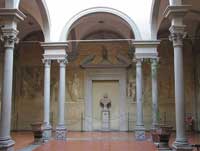 |
||||
Abbazia di Monte Oliveto Maggiore |
Piazza della Santissima Annunziata in Florence |
Choistro dello Scalzo, Florence |
||
The façade and the bell tower of San Marco in Florence |
Piazza della Santissima Annunziata in Florence |
Florence, Duomo |
||

